Meet Lloyd Wolf, a Jewish photographer who captured photos of the Capitol mob
Published January 13, 2021
(JTA) — When Lloyd Wolf heard the long blast from a shofar at the Jan. 6 Stop the Steal protest, the photographer was determined to find the source. He found two women, one with a prayer shawl wrapped around her head, the other holding a shofar painted with an American flag motif, and snapped a picture.
Wolf, a freelance photographer based in the Washington, D.C., area, said he joked with the women about whether they would be sounding the blasts typically heard during High Holiday services.
“Are you going to do three shevarim also?” he asked them — and got blank stares in return.
ADVERTISEMENT
Wolf only expected to hear shofar blasts at High Holiday services at the Fabrangen Havurah in D.C., where he has a membership.
“I think what they were doing was trying to blow the shofar like Joshua,” Wolf said, referring to the Jewish warrior’s blasts that brought down the walls of Jericho in a biblical saga about resisting corrupt governments. That story inspired at least some of the Trump supporters who convened last week in Washington to protest the outcome of the presidential election.
The shofar has been taken up as a symbol by evangelical Christians, who make up many of Trump’s supporters. The shofar blowers Wolf encountered were just a small part of a much larger crew of Trump supporters — including extremist Proud Boys and QAnon supporters — that he photographed at the Capitol.
A week after the event, Wolf said he was worried that the mostly maskless protesters had infected him with COVID-19 and was planning to be tested for the virus after developing a sore throat and fatigue. But he said he also was concerned that another affliction might lie ahead for people like him who documented the shocking event: post-traumatic stress, of the sort that debilitated him after taking pictures at the site of a terror bombing in Jerusalem.
ADVERTISEMENT
We spoke with Wolf, who has snapped shots of every president from Reagan to Trump, about his experience photographing the Capitol mob, how he expects the event to remain in his memory and what he thinks Jews can learn from this moment.
This interview has been edited for length and clarity.
JTA: What brought you to the Capitol on Jan. 6? Did you know something was brewing?
Wolf: Four years ago, I was one of about 20 or 30 photographers involved in a book “UnPresidented,” about Trump’s inauguration, the counterprotests and the Women’s March. Recently Joe Newman, the photo editor, suggested we get the band back together for a book on the transition of power, which is what we did.
That day, I decided to go to the east side of the Capitol, which was one of the areas where it was clear that they were going to demonstrate, and position myself there. I got there about 10:30 a.m. in the morning, and stayed until just a little before 4.
So heading down there, you knew there were risks, either from COVID-19, with people not wearing masks, or even just violence. What made you want to head down there in spite of all that?
I did feel nervous the day before, but I told friends and family publicly, ‘Look, I’m gonna go down,’ which is kind of my way of talking myself into it. I was a little worried, but I said this is a historic event. This is what we do. You know, I’ve been to Colombia, I photographed a bombing in Jerusalem. I tend not to be easily frightened, though I have a healthy sense of self-preservation.
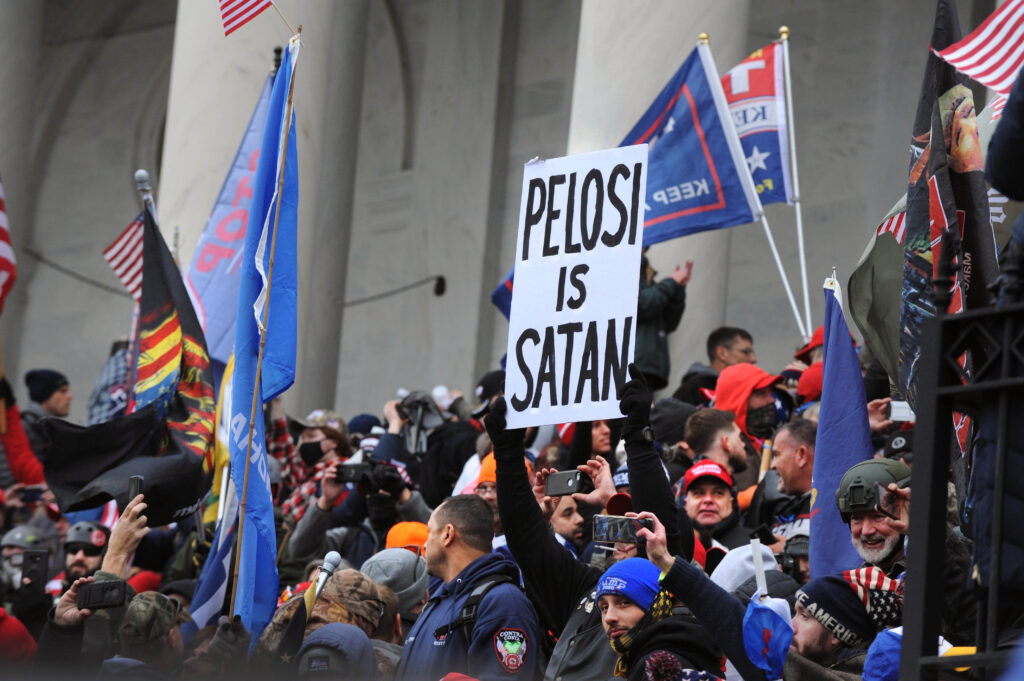
(Lloyd Wolf)
So what did you see when you got down there?
There were not many people when I got there, maybe a few hundred on that side of the Capitol. I was on the east side that faces the Supreme Court and the Library of Congress. Then the broadcasts of the president’s long rambling speech changed the mood of the crowd. More people started arriving. I couldn’t hear all of it, but people were holding up phones and Bluetoothing it to various little speakers and things so you could hear his voice.
Then it wasn’t just yelling and screaming and waving signs. There was some of that, too, but the frenzy level went higher. After the president’s speech, a large body [of people] came up from Constitution and Pennsylvania Avenue, on the side I was on.
But what I didn’t know is that there was an even larger body of people on the other side of the Capitol.
Do you remember what they were yelling and screaming?
“Hang Biden,” “Stop the steal” or “We’re for Trump” or “We’re the party of Trump.” Those were the main ones you would hear. There was also an evangelical Christian prayer meeting going on to one side, where they were speaking in tongues, trying to prayerfully exhort the Congress to do what they felt was God’s will, to remove Satan from their hearts.
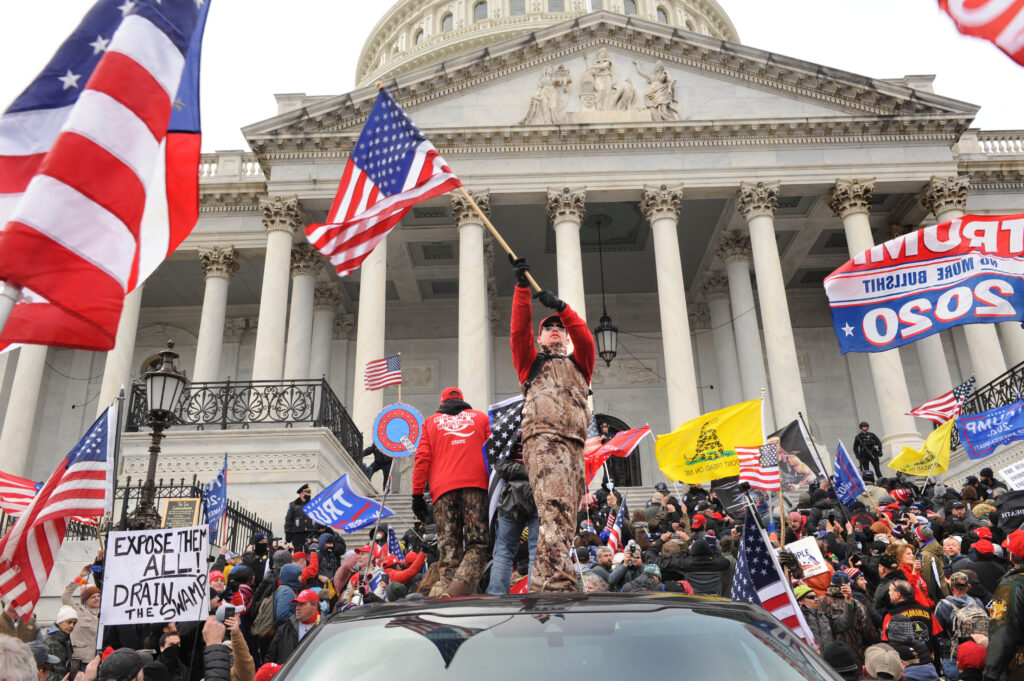
(Lloyd Wolf)
What other signs or symbols did you see?
There was someone walking around with an Israeli and a Mexican flag. I did not see the fellow with the Camp Auschwitz T-shirt, though I must have been very near him based on a picture I saw. There were a number of Proud Boys wearing black and yellow. There was QAnon, there were Three Percenters, obviously a great variety of MAGA hats, some Second Amendment signs, Confederate flags.
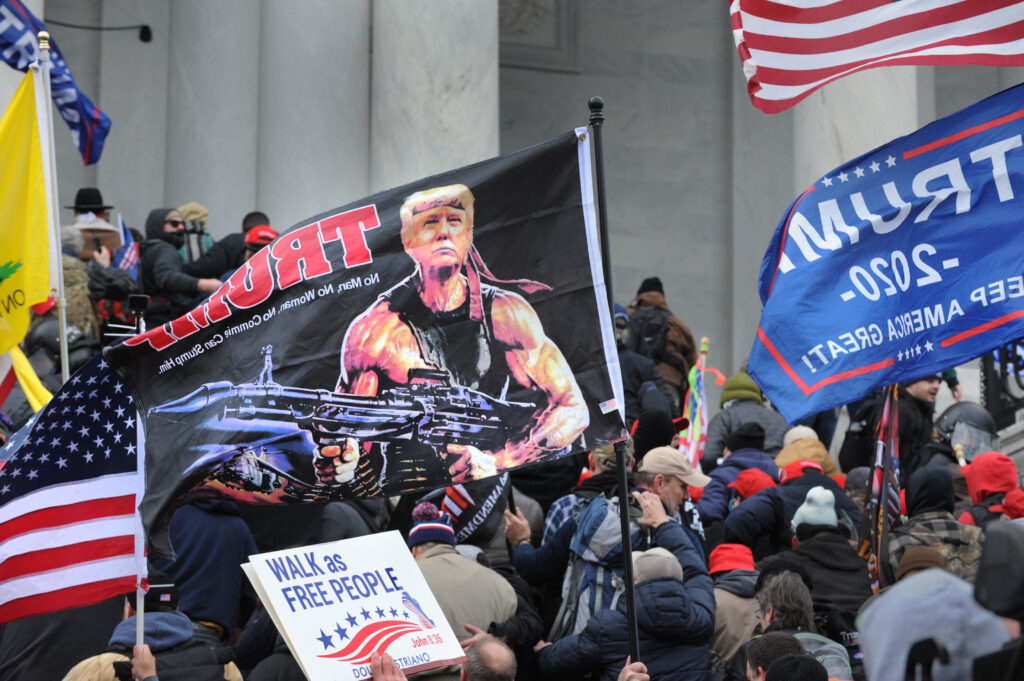
(Lloyd Wolf)
One flag said in big letters “Jesus is my Savior. Trump is my president.” There was another flag where somebody grafted Trump’s head onto the standard movie poster of Rambo, with Trump, bare-chested, holding this big rocket launcher.
The place was colorful, like a Renaissance Faire or a Grateful Dead show or Comic Con. People wore all kinds of stuff. Mostly there were a lot of people in camouflage. The majority of the people I saw [looked like] white working-class people, probably rural, a few sort of “country club Republicans,” but a small number.
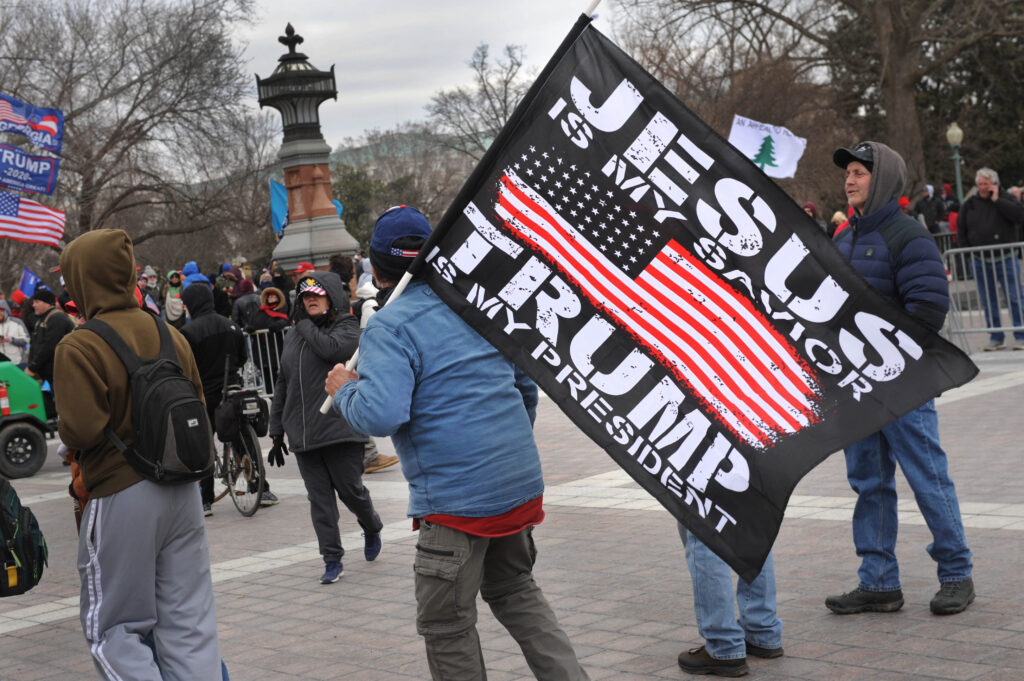
(Lloyd Wolf)
And it looks like people were blowing shofars. What was going on there?
I heard the sound of a tekiyah gedolah and found them. There were two women blowing shofars. One was painted up in American flag motif and one of them had a tallit wrapped around her head, which had red piping on it, which I’m told is common among Messianic Jews.
I asked them, ‘Are you going to do three shevarim also?’ [Shevarim are medium-length blasts blown on Jewish holidays.] And they had no idea what I was talking about. They said, ‘Are you Jewish?’ And I went, yes. And they said ‘Shalom,’ which was I think the extent of their Hebrew. And they talked to other people about how powerful they were.
I think what they were doing was trying to blow the shofar like Joshua.
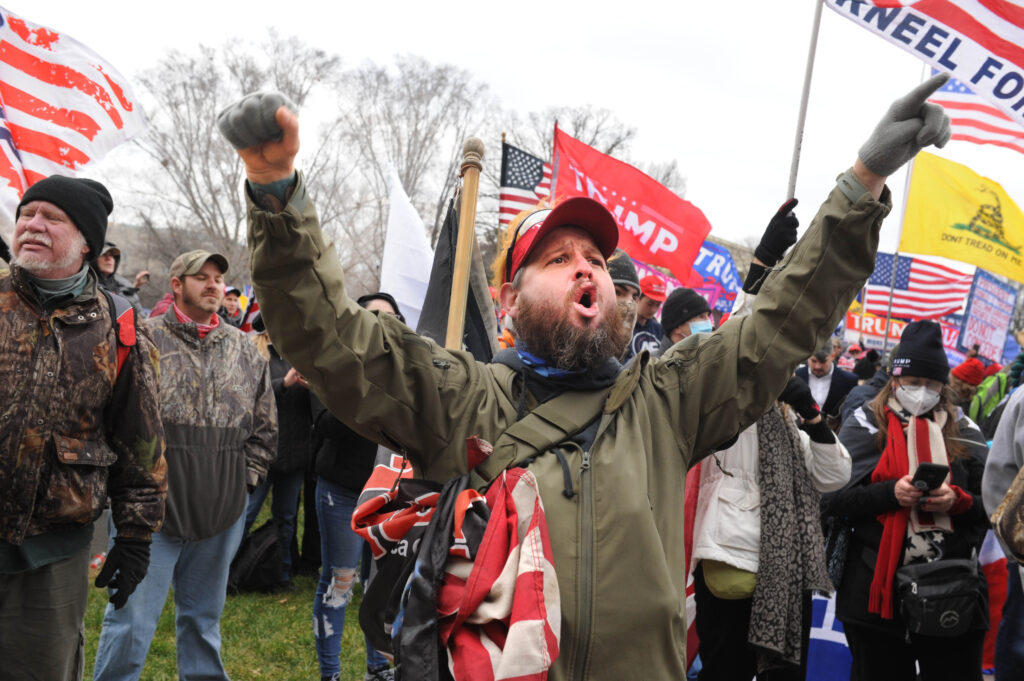
(Lloyd Wolf)
Did you feel particularly vulnerable as a Jew among this crowd?
First of all, I was completely masked up. You could hardly see my face and I had gloves on. I normally wear a Black Lives Matter mask in public. I did not do that. I knew that would be a trigger for them, and frankly, could have gotten me beat up.
I did hear from someone in the crowd that they had roughed up a Washington Post reporter, and that that person had taken their credential off and gone back into the crowd.
A couple people kind of taunted me, saying we don’t like the media, you’re pretty ballsy coming up here, that kind of thing. One woman said, ‘You’re real brave being up here. We don’t like the media,’ and I said, ‘Well, I’m just trying to tell the truth, ma’am.’
I ran into my colleague Lucian Perkins, who’s won two Pulitzers, and I said, ‘Did you ever think you’d be covering a fascist riot at the Capitol?’ and we kind of shrugged and went back to work. I learned from my colleagues that some photographers were beaten, I know one from The Associated Press took it hard.
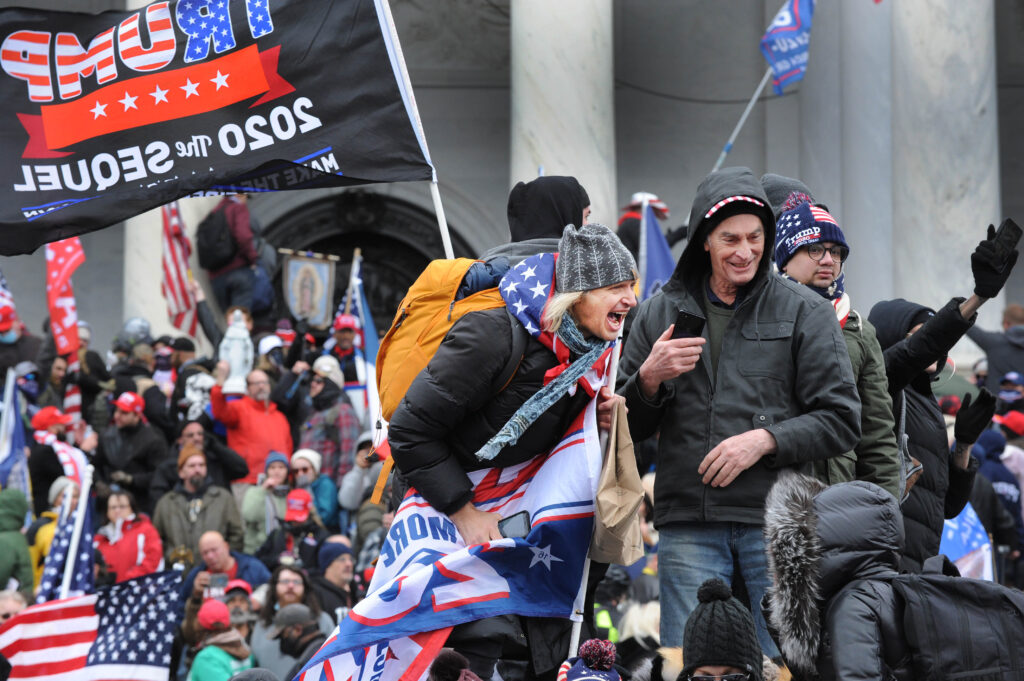
(Lloyd Wolf)
So what happened after the crowd got more frenzied?
I saw people push the barrier aside, and there were only three or four cops in that whole Center Plaza. The cops kind of looked at each other and there was nothing they could do. About 50 people ran up, and there was a hush for a moment of apprehension, of what’s going to happen in the crowd.
Once the crowd saw that nobody would do anything, it was like a dam breaking: Something like thousands ran up in less than a minute. They were all jumping up and dancing and hooting and hollering like a bunch of howler monkeys, waving their flags and screaming. Half of them looked like they were in a hunters convention, with a “Duck Dynasty” kind of look.
The police made an effort to keep them off the stairs. The timing escapes me because so much was going on and I was also trying not to get caught and yelled at, but I backed up a little bit and they rushed the stairs. At least two-thirds of them were taking selfies as they charged the Capitol. The cops were completely overwhelmed.
I heard some of them saying ‘we’re in the basement.’ I thought to myself, if you’re in the basement, the Capitol Police will round them up and it’ll be over. I didn’t know that hundreds, if not more, were pouring in on the other side.
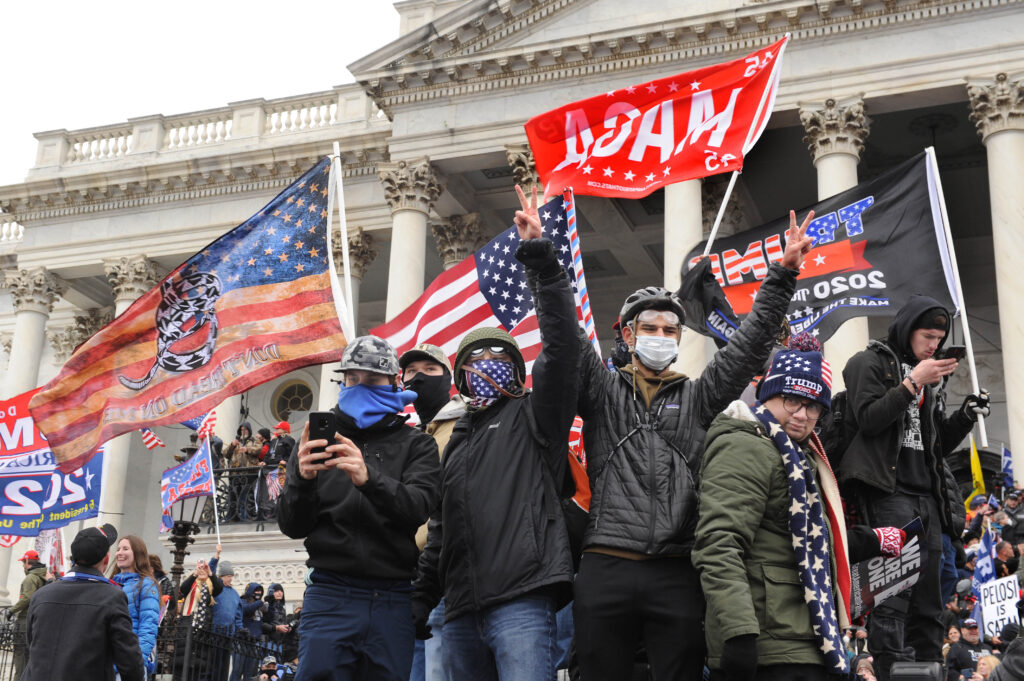
(Lloyd Wolf)
What kept you photographing in the chaos?
My father grew up in Frankfurt, Germany, in the Nazi era. He came to America, was in the American Army. His unit was part of the group that opened Buchenwald. My father was pretty quiet about it, but occasionally he would talk about what had happened in Frankfurt. On his bar mitzvah day, he was terrified of getting beaten up by thugs because his mother dressed him in a nice suit with a black fedora hat on his head.
The Proud Boys are the equivalent of Hitler’s SS. [The SS was Nazi Germany’s official secret police; the Proud Boys are a loosely organized group of far-right extremists who have supported Trump but do not work for the government.] In the midst of this howling mess, they kept saying ‘this is our house, this is our place,’ and it is, in a sense, but it’s not theirs. It came to me that this fascist thuggery and oppression is what my father came from America to get away from.
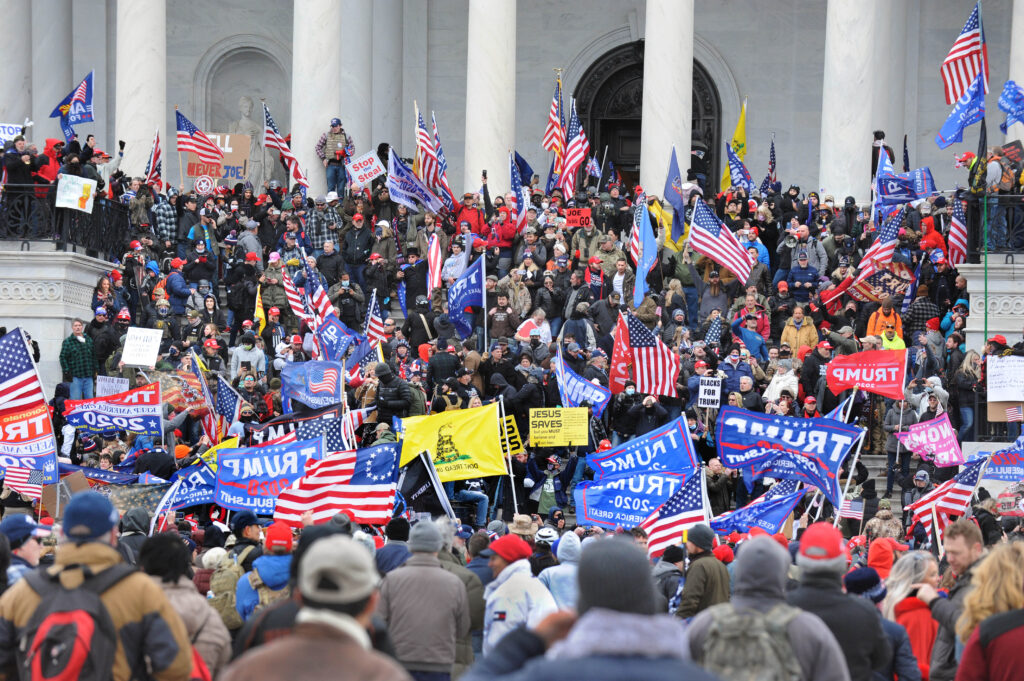
(Lloyd Wolf)
What were you thinking as all this went on?
I was thinking this has never happened. This is historic, I’ve got to stay here. And then it was a little disorienting walking away because Capitol Hill is a pretty nice neighborhood and there were people walking their dogs and jogging a block away from the maelstrom.
When I came away from that thing, I was shaken up. I was always calm, collected, focused on doing my job when I was there. But I came home to my partner, Ruth, and said ‘I’m OK, but I’m going to have a little PTSD stuff for a couple days.’ And that was true.
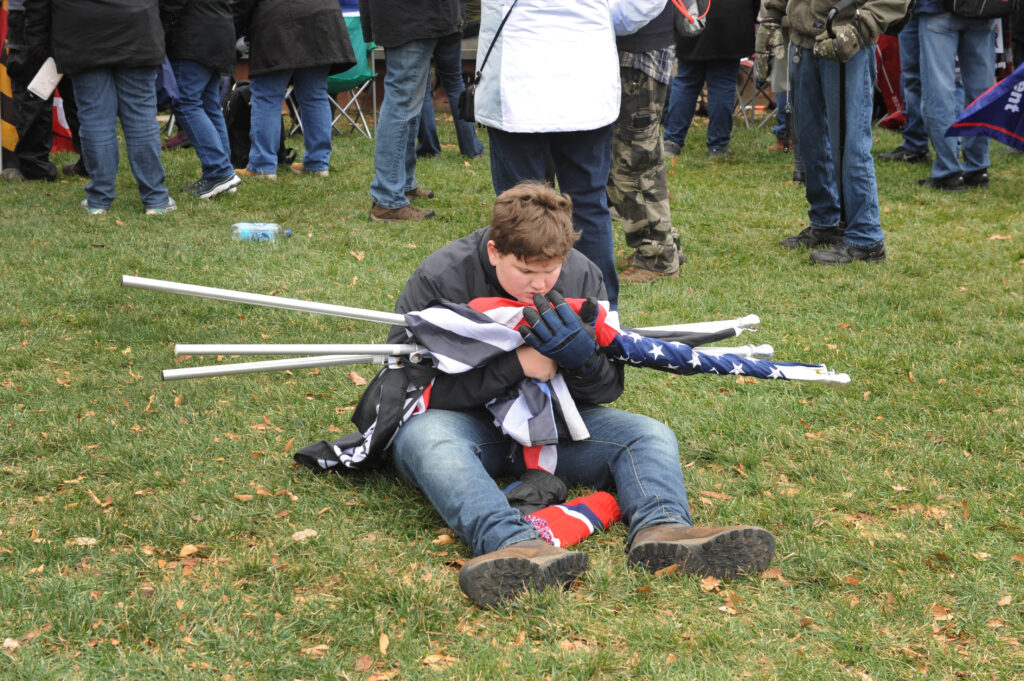
(Lloyd Wolf)
What kind of PTSD symptoms are you having?
I’m having flashbacks. I know from having photographed a bombing in Jerusalem, with bodies all over the street being bagged up, that something just comes down to protect you as a journalist and you just keep working.
About a week after the bombing, I was with my writer and I was crying. Since then, periodically, that stuff comes back into my consciousness. And I think the same will happen with this. It will reemerge. But we’re designed psychologically to look at it in pieces because otherwise you freak out, you can’t function. And that’s not how I’m wired.
And are you preparing to photograph at the inauguration?
If I’m well, if it’s safe to go down, I will go down. I am planning on going back.
I’m fine now. I’ve been threatened and hurt worse in the past. But this is in our own country. It was at the Capitol. And it was big. It was just like being inside a storm.














